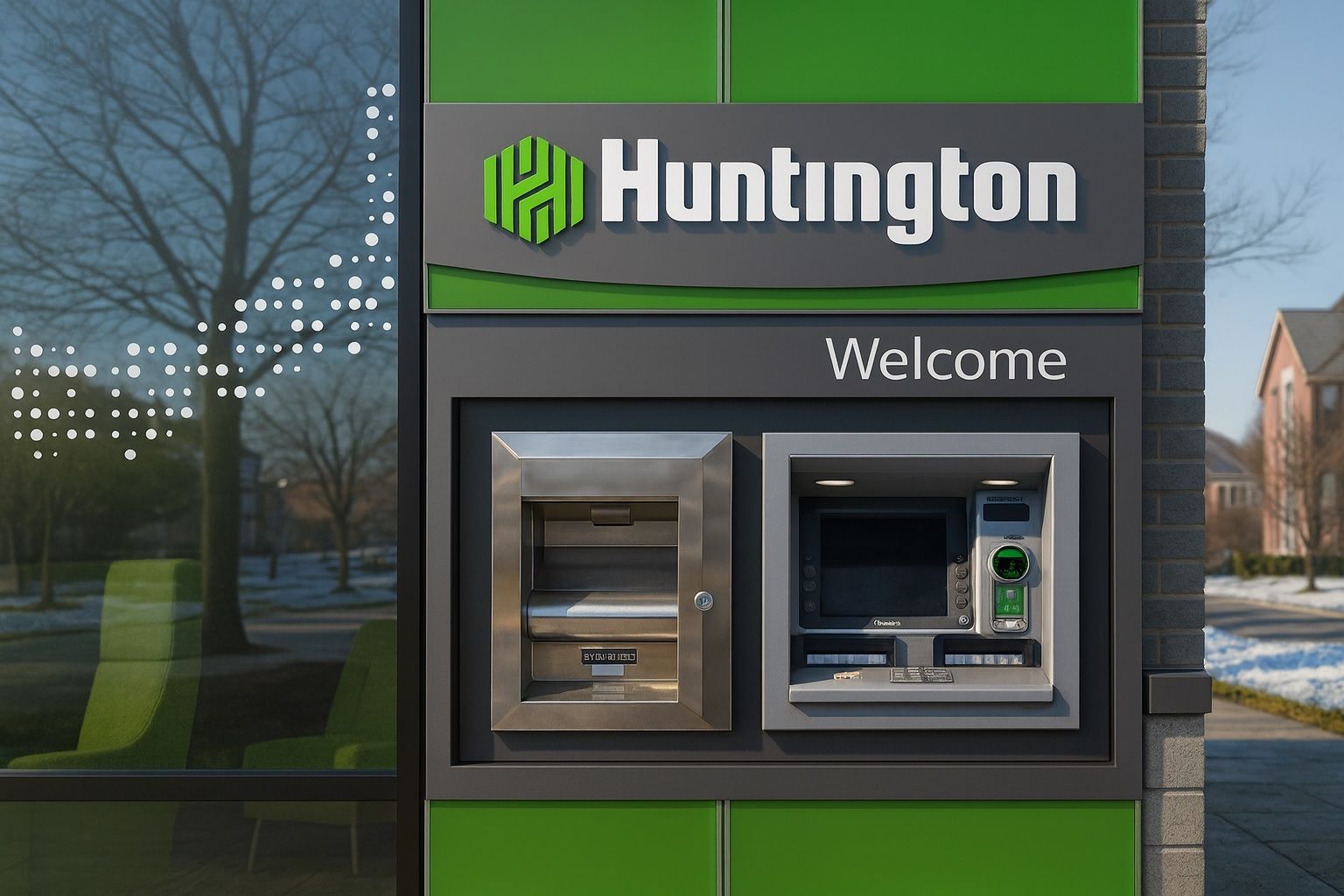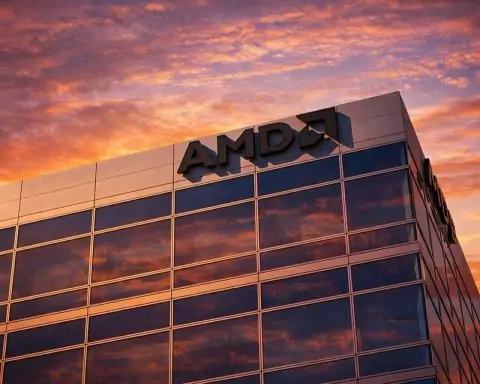- Stock Rebounds After Slide: Huntington Bancshares (NASDAQ: HBAN) stock traded around the mid-$15 range on Oct. 17, 2025, rising about 2% after the bank’s latest earnings beat expectations [1] [2]. This uptick followed a sharp 5% drop the day prior amid a broader regional-bank selloff [3]. At current prices, HBAN yields over 4% annually, appealing to dividend investors [4].
- Earnings Beat Estimates:Q3 2025 net income jumped 22% year-over-year to $629 million, or $0.41 per share [5]. Adjusted for one-off items, earnings were $0.40 per share, topping Wall Street’s ~$0.38 consensus [6]. Revenue (net of interest expense) hit $2.15 billion, also above forecasts ($2.06 B) [7].
- Interest & Fee Income Soar: Huntington benefited from higher interest income – up 11% to $1.51 billion – as rising loan balances and lower deposit costs widened margins [8] [9]. Non-interest income surged 20% year-on-year, led by a 21% jump in capital markets and advisory fees amid a rebound in dealmaking [10]. Deposit and loan fees climbed nearly 19%, reflecting healthy loan growth and commitment fees [11].
- Strong Loan Growth, Stable Credit: Average loans grew ~9% vs. a year ago, fueling interest income [12]. Credit quality remains solid – net charge-offs were just 0.22% of loans [13]. Provision for credit losses increased to $122 million (from $106 M a year prior) as a precaution [14], but key bad-loan ratios improved slightly. Executives affirm Huntington’s “top tier” asset quality and ample capital buffers (CET1 ratio ~10.6%) [15] [16].
- Dividend Steady, Yield ~4%: The bank paid a quarterly $0.155 per share dividend on Oct. 1 and is expected to maintain that payout, which translates to a 4%+ yield at current stock levels [17]. Huntington’s dividend is well-supported by earnings (a ~$0.62 annual dividend is about 50% of projected 2025 EPS) and the bank’s capital position. No dividend cut warnings have emerged, in contrast to some weaker regional banks earlier in the year.
- Merger on Deck: Huntington is expanding into Texas via an upcoming merger with Veritex Holdings. The combination is scheduled to close on Oct. 20, 2025 [18], positioning HBAN to grow in one of the nation’s most dynamic markets. Management touts the Veritex deal as a “major catalyst” for long-term growth in Texas [19] [20]. The bank’s tangible book value per share jumped 10% year-over-year, partly reflecting this strategic expansion [21].
- Analyst Sentiment & Outlook: Wall Street’s stance on HBAN is cautiously optimistic. About 20 analysts cover the stock with a consensus “Moderate Buy” rating [22]. Over the past year, the average price target has climbed from roughly $19 to $23 as analysts gained confidence [23]. This implies significant upside from current prices. For full-year 2025, the Street forecasts double-digit earnings growth (projected EPS ~$1.40, +12–13% YoY) [24]. Huntington has beaten earnings estimates in each of the last four quarters, bolstering credibility with investors.
HBAN Stock Bounces After Regional Bank Rout
HBAN shares are attempting a comeback after a volatile week. On October 16, Huntington’s stock slid 5.2% to $15.37 [25] amid a broader rout in regional bank stocks. Credit jitters hit the sector after a “cockroach” of bad loan news – one mid-sized lender disclosed a fraud-linked loss and another flagged sour commercial loans [26] [27]. The KBW Regional Bank Index plunged ~6.5% that day [28], dragging down even healthy banks like Huntington.
However, Huntington’s strong earnings report on Friday, Oct. 17 helped ease those fears. The bank’s better-than-expected results and upbeat guidance sparked a relief rally in HBAN and peers. Huntington’s stock opened higher and hovered in the mid-$15s, up roughly 2% intraday [29] [30]. Similarly, Truist Financial – another regional lender – saw its shares jump 2% pre-market on an earnings beat, signaling that solid Q3 profits are reassuring investors [31]. By outperforming forecasts and showing resilient credit quality, Huntington appeared to “buck the pessimism” that clouded the sector a day earlier [32].
Even after this rebound, HBAN remains slightly down ~5–6% year-to-date, roughly in line with the regional bank index’s decline [33]. The stock has underperformed the broader S&P 500 (which is up modestly in 2025) but has fared better than some regional peers that endured steeper losses during the spring 2023 banking turmoil. Investors’ confidence in the sector is still fragile, so Huntington’s ability to deliver stable results was a welcome surprise. One day’s good news doesn’t erase all worries, but for now HBAN’s uptick suggests selling pressure is abating as fundamentals reassert themselves.
Q3 Earnings: Profit Jumps on Interest and Fee Windfall
Huntington’s third-quarter 2025 earnings showcased robust growth powered by higher interest rates and renewed fee revenue streams. Net income surged 22% from a year ago to $629 million [34], with earnings per share of $0.41 easily outpacing last year’s $0.33. This marked Huntington’s fifth straight quarterly beat of analyst expectations – the bank delivered $0.40 adjusted EPS versus the $0.38 consensus [35], and management raised full-year guidance on several metrics (loans and net interest income).
What drove the profit spike? In short, rising interest income and a revival in dealmaking fees. Huntington’s net interest income – essentially its lending profit after funding costs – climbed to $1.51 billion, up 11% year-over-year [36]. This was fueled by loan growth (average loans +9% YoY) and lower deposit costs, which together expanded the bank’s net interest margin. Notably, the Federal Reserve’s first rate cut of the year in September helped ease funding pressures for banks [37]. With deposit rates leveling off and loan demand holding up, Huntington was able to boost interest income even as the Fed began gently lowering rates. Executives noted that further Fed rate reductions expected in coming months could bolster margins and credit growth into 2026 [38].
Meanwhile, non-interest (fee) income provided an even bigger lift – jumping 20% from a year ago [39]. The bank earned record fees from capital markets advisory, as mergers and acquisitions roared back after a quiet stretch. In Q3, Huntington’s investment banking and advisory fees leapt 21% on a wave of deal closings and new underwriting mandates [40]. This mirrors trends at peers: “Dealmaking rebounded in the third quarter,” Reuters notes, marking a clear turning point that benefited many banks’ fee lines [41] [42]. Huntington also saw healthy growth in deposit service charges, card fees, and wealth management income, reflecting its diversified business mix.
Crucially, this fee boost comes on top of the interest gains. Huntington’s total revenue (FTE) grew to $2.15 billion (net of interest expense) [43]. That’s up ~5% year-over-year and ahead of analyst forecasts around $2.06 B [44]. In other words, Huntington is not just coasting on high interest rates – it’s also firing on multiple cylinders with growth in lending and non-lending streams.
The bank did set aside a bit more for potential loan losses this quarter – a $122 million provision, up from $106 M in Q3 2024 [45]. This reflects a cautious stance amid an uncertain economy. However, there’s no sign of serious credit deterioration. Actual loan charge-offs remained low (0.22% of loans) and non-performing assets fell slightly to 0.60% of the portfolio [46] [47]. Huntington’s CEO, Steve Steinour, emphasized that “credit quality remains top tier” and the bank continues to be “disciplined” in managing risk [48]. The slight uptick in reserves is seen as prudent housekeeping given some industry headwinds (e.g. troubled auto loans at a few lenders). Overall, Huntington’s Q3 results show a balanced growth story – strong core revenues coupled with stable credit metrics, a combination that stood out positively against the fear-driven narrative plaguing bank stocks earlier in the week.
Dividend Yield Tops 4% – Income Investors Take Note
One side effect of HBAN’s recent share price dip is an unusually high dividend yield for a large regional bank. With shares still around the mid-teens, Huntington’s annual dividend of $0.62 per share now equates to roughly a 4.0%+ yield [49]. This is well above the S&P 500’s average yield (~1.5%) and even higher than many big bank peers. For investors seeking stable income, HBAN’s payout looks attractive – if it’s sustainable.
So far, Huntington’s management has given every indication the dividend is on solid ground. The bank held its quarterly $0.155 dividend steady in Q3 (paid Oct. 1, 2025) and is expected to declare a similar payout for Q4 (likely payable January) barring any surprises [50]. At the current earnings run-rate (roughly $0.40 per quarter), the dividend represents about half of quarterly profits, a comfortable payout ratio around 50%. This leaves plenty of retained earnings to bolster capital or fund growth initiatives. In fact, Huntington’s tangible book value per share rose 10% over the past year even after paying dividends, suggesting the bank is generating more than enough profit to cover shareholder returns [51].
Importantly, Huntington avoided the dividend cuts that some smaller regionals were forced into during early 2023’s banking scare. Its dividend has held at $0.155 per quarter throughout 2024–2025. The bank’s ample capital cushion (Common Equity Tier 1 ratio 10.6%) and improving earnings trend add confidence that the 4% yield isn’t a red flag but rather a reflection of an undervalued stock [52]. As TS².Tech noted in a market brief, a “meaningful yield can boost long-run returns even amid price declines,” especially if that payout holds steady [53]. Huntington’s current yield, recently highlighted as crossing the 4% threshold [54], puts it on the radar of income-focused investors scouting for bargains among beaten-down financials.
Of course, dividends are never guaranteed. Investors will be watching Huntington’s upcoming earnings calls and stress tests for any hints of constraint. For now, though, analysts see no cut on the horizon – HBAN’s earnings outlook comfortably covers the dividend, and management signaled ongoing commitment by ranking Huntington as a top income payer in its peer group. If anything, the high yield underscores potential upside: should bank sentiment normalize, HBAN’s stock could appreciate (lowering the yield) to more in-line levels given its fundamentally sound position.
Analyst Sentiment: Cautious Optimism with Upside Potential
Despite the rocky year for bank stocks, Wall Street analysts have largely maintained a constructive view on Huntington. The consensus rating sits around a “Moderate Buy”, skewing positive. In fact, none of the major research firms currently advise selling HBAN – a sign that experts see value in the shares at these depressed prices [55] [56]. Among roughly 20 analysts tracked, over half rate HBAN a Buy, with the remainder mostly Holds and only a rare underperform here or there [57]. This relatively upbeat stance differentiates Huntington from certain troubled peers that have attracted bearish calls.
Price targets tell a similar story. The average 12-month target for HBAN now stands in the low $20s per share [58]. Even the more conservative analyst models generally peg the stock around the high teens. As of mid-October, the consensus target was about $23, up from ~$19 a year ago [59] – reflecting a positive shift in sentiment over the past year as Huntington delivered steady growth. That $23 target implies ~45% upside from the ~$15.50 level, underlining that HBAN is viewed as undervalued. Some analysts have explicitly highlighted the disconnect: at around 9–10× forward earnings, Huntington trades at a discount to historical multiples for a profitable, growing regional bank [60] [61].
In terms of forecasts, the Street expects Huntington to continue its earnings growth trajectory into next year. For full-year 2025, analysts project around $1.40 in earnings per share, which would be a ~13% jump from 2024’s results [62]. Notably, Huntington has outperformed the consensus in each quarter so far, so some analysts see upside to those estimates if economic conditions cooperate. Several firms raised their estimates or price targets after Q3’s beat, citing Huntington’s “balanced, above-peer growth” and successful expansion efforts [63] [64]. The bank’s strategic moves, like the Veritex acquisition, have also factored into more optimistic models projecting enhanced earnings power in new markets.
To be clear, not everyone is pounding the table – a number of analysts are in “hold and wait” mode given the uncertain macro climate. But the lack of outright bearish calls is telling. Even cautious observers acknowledge Huntington’s resilience. For example, Raymond James analysts (who have one of the lower price targets at ~$18) still voice a “positive outlook” and see the bank as fundamentally sound [65] [66]. The consensus seems to be that Huntington’s management is executing well, positioning the bank to weather any credit headwinds. As long as a severe recession or credit crisis is averted, many experts believe HBAN stock has room to re-rate higher from its current beaten-down valuation.
Broader Context: Banking Sector Trends Shaping HBAN
Huntington’s latest results and stock action can’t be fully understood in isolation – they tie into several bigger trends in banking and markets:
- Interest Rate Cycle: After an aggressive series of rate hikes in 2022–early 2025, the Federal Reserve finally cut rates in September 2025, a first step toward monetary easing [67]. This pivot has mixed effects on banks. In the short run, it relieves pressure on funding costs (banks can lower deposit rates) and may spur loan demand – both positives noted by Huntington and peers [68]. Truist’s management, for instance, said the cut “helped ease funding pressures and spur loan demand” [69]. Huntington similarly cited lower funding costs aiding its Q3 margin [70]. Looking ahead, expectations of further Fed rate cuts are “fueling optimism for improved margins and stronger credit growth,” according to Reuters [71]. Essentially, a gentler rate environment in 2026 could extend the tailwind for HBAN’s net interest income – a notable shift from early 2023 when soaring rates were squeezing many banks.
- Credit Quality Concerns: The flip side is lingering credit risks. Recent headlines about loan losses have kept investors on edge. In mid-October, two auto finance companies (First Brands and Tricolor) went bankrupt, and a separate lending fraud came to light, stoking worries that more “cockroaches” could emerge in banks’ loan books [72] [73]. Huntington itself hasn’t reported any such issue; its loan portfolio is broadly performing well. Still, the bank boosted reserves slightly this quarter “amid renewed scrutiny of credit quality” in the industry [74]. CEO Steinour reassured that Huntington’s credit discipline is intact, and so far the data backs that up (stable delinquencies, modest charge-offs) [75]. The market’s reaction – dumping all regional bank stocks on Oct. 16 – arguably over-penalized names like HBAN that have fortress balance sheets. As one analyst quipped, investors “never fully stopped peering nervously at regional lenders’ loan books” after the Silicon Valley Bank saga [76] [77]. Huntington’s challenge (and opportunity) is to prove those fears overblown by continuing to post steady credit results, which could help narrow the valuation gap caused by fear-driven selling.
- Resilient Peer Performances: Huntington is not alone in delivering upbeat earnings. Many regional and major banks this quarter showed surprisingly strong results, thanks to the same interest-rate and fee-recovery dynamics. For example, Regions Financial (Alabama-based) saw its Q3 profit rise and capital markets income jump, with shares up ~1% on its report [78] [79]. Fifth Third Bancorp boasted a 17% EPS increase and even resumed stock buybacks [80]. And larger banks like JPMorgan and Bank of America benefited from the M&A rebound and robust consumer spending. This widespread strength suggests the U.S. banking system is on firmer footing than feared. Huntington’s 22% profit surge was in fact ahead of many peers (e.g., Regions’ profit was up ~23% but off a smaller base [81]). In short, Q3 earnings have been “better-than-feared” across the board [82], helping to stabilize bank stocks after a volatile year. This broader context bodes well for HBAN: if the narrative shifts from doom to “back to fundamentals”, quality operators like Huntington could see renewed investor interest.
- Strategic Growth Moves: Beyond the quarter, Huntington is actively positioning for the future. The imminent Veritex Holdings acquisition is a prime example. By acquiring Texas-based Veritex, Huntington extends its footprint into the high-growth Dallas/Fort Worth region [83]. Texas offers a booming economy and diversification away from the Midwest. Management calls this expansion a “powerful platform for long-term growth”, noting that Veritex’s team and client base will complement Huntington’s model [84]. The deal underscores Huntington’s expansion mindset – even amid industry caution, it’s playing offense, not just defense. Analysts view the move positively, anticipating the merger will “influence future expectations and the stock’s consensus price target” once the benefits accrue [85] [86]. Successful integration will be key, but if Huntington can replicate in Texas what it’s achieved in its core Midwest markets, it could unlock a new leg of growth (and justify those higher analyst targets).
Conclusion
Bottom Line: Huntington Bancshares entered the Q3 earnings season with skeptics expecting more bad news for regional banks. Instead, it delivered a robust beat, showcasing double-digit profit growth, improving revenues, and stable credit. The stock’s jump on Oct. 17 suggests investors took notice, and its rich 4% dividend yield pays shareholders to wait for a fuller recovery. Significant challenges remain – economic uncertainty and latent credit fears won’t vanish overnight – but Huntington’s results highlight that not all regional lenders are in the same boat. With a strategic merger on tap and analysts leaning bullish, HBAN could be poised to re-rate higher if it continues executing well.
For now, Huntington’s earnings resurgence stands out as a bright spot in a beleaguered sector. The bank managed to “mirror peers… whose profits also jumped” this quarter [87], while avoiding the stumbles that sank others. In doing so, it may have regained the market’s benefit of the doubt. Investors will be watching the next few weeks closely – from the Veritex deal closing to any macro news – but Huntington Bancshares has given them a reason for renewed confidence heading into year-end.
Sources: Huntington Q3 earnings release and conference call; Reuters, Associated Press and Bloomberg reports on Oct. 17, 2025; TS².Tech market analysis and financial news briefs [88] [89] [90] [91] [92]; Analyst consensus data from Nasdaq/Barchart [93] [94]; Sector commentary from Reuters and TS².Tech [95] [96]. All information is as of October 17, 2025.
References
1. www.reuters.com, 2. www.investing.com, 3. ts2.tech, 4. ts2.tech, 5. www.reuters.com, 6. www.indexbox.io, 7. www.indexbox.io, 8. www.reuters.com, 9. www.reuters.com, 10. www.reuters.com, 11. www.reuters.com, 12. www.prnewswire.com, 13. www.prnewswire.com, 14. www.reuters.com, 15. www.prnewswire.com, 16. www.prnewswire.com, 17. ts2.tech, 18. www.prnewswire.com, 19. site.financialmodelingprep.com, 20. www.prnewswire.com, 21. www.prnewswire.com, 22. www.nasdaq.com, 23. site.financialmodelingprep.com, 24. www.nasdaq.com, 25. markets.financialcontent.com, 26. ts2.tech, 27. ts2.tech, 28. ts2.tech, 29. www.reuters.com, 30. www.investing.com, 31. www.reuters.com, 32. ts2.tech, 33. www.reuters.com, 34. www.reuters.com, 35. www.indexbox.io, 36. www.reuters.com, 37. www.reuters.com, 38. www.reuters.com, 39. www.reuters.com, 40. www.reuters.com, 41. www.reuters.com, 42. www.reuters.com, 43. www.indexbox.io, 44. www.indexbox.io, 45. www.reuters.com, 46. www.prnewswire.com, 47. www.prnewswire.com, 48. www.prnewswire.com, 49. ts2.tech, 50. www.dividendmax.com, 51. www.prnewswire.com, 52. www.reuters.com, 53. ts2.tech, 54. ts2.tech, 55. site.financialmodelingprep.com, 56. site.financialmodelingprep.com, 57. www.nasdaq.com, 58. site.financialmodelingprep.com, 59. site.financialmodelingprep.com, 60. site.financialmodelingprep.com, 61. site.financialmodelingprep.com, 62. www.nasdaq.com, 63. www.prnewswire.com, 64. www.prnewswire.com, 65. site.financialmodelingprep.com, 66. site.financialmodelingprep.com, 67. www.reuters.com, 68. www.reuters.com, 69. ts2.tech, 70. www.reuters.com, 71. www.reuters.com, 72. ts2.tech, 73. ts2.tech, 74. www.reuters.com, 75. www.prnewswire.com, 76. www.marketscreener.com, 77. www.marketscreener.com, 78. www.reuters.com, 79. www.reuters.com, 80. www.marketscreener.com, 81. www.reuters.com, 82. ts2.tech, 83. site.financialmodelingprep.com, 84. www.prnewswire.com, 85. site.financialmodelingprep.com, 86. site.financialmodelingprep.com, 87. www.reuters.com, 88. www.reuters.com, 89. www.indexbox.io, 90. ts2.tech, 91. ts2.tech, 92. www.marketscreener.com, 93. www.nasdaq.com, 94. www.nasdaq.com, 95. www.reuters.com, 96. ts2.tech










